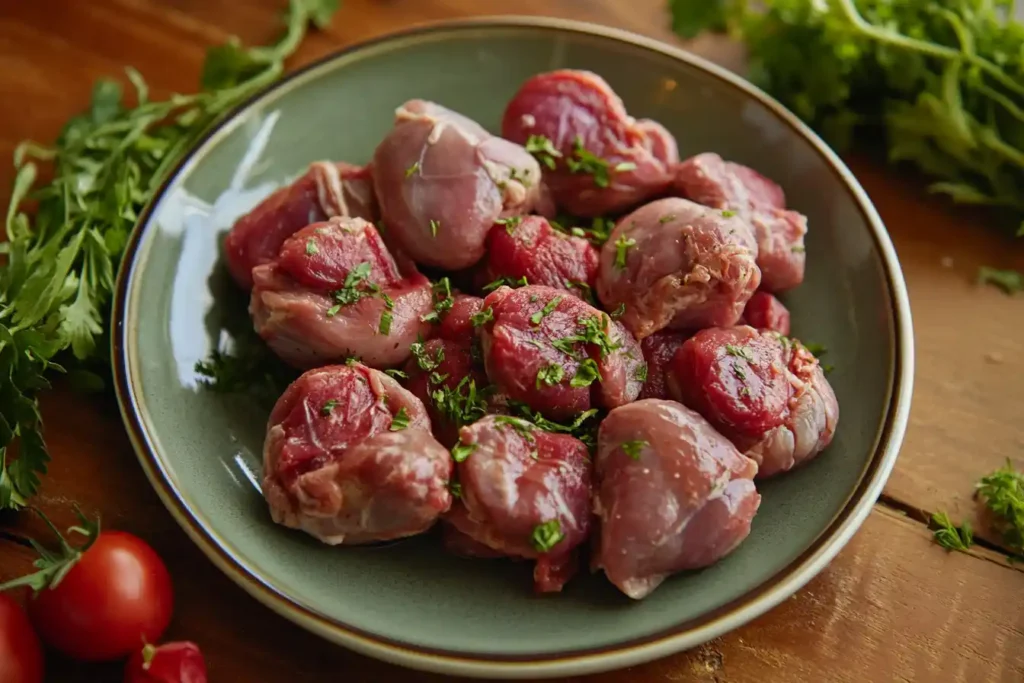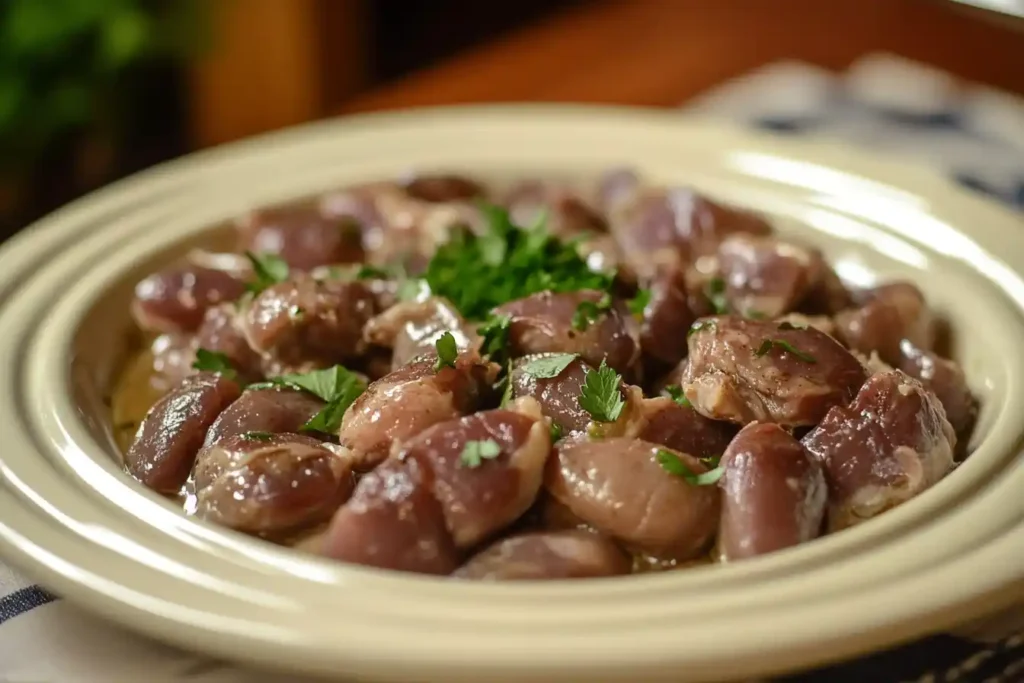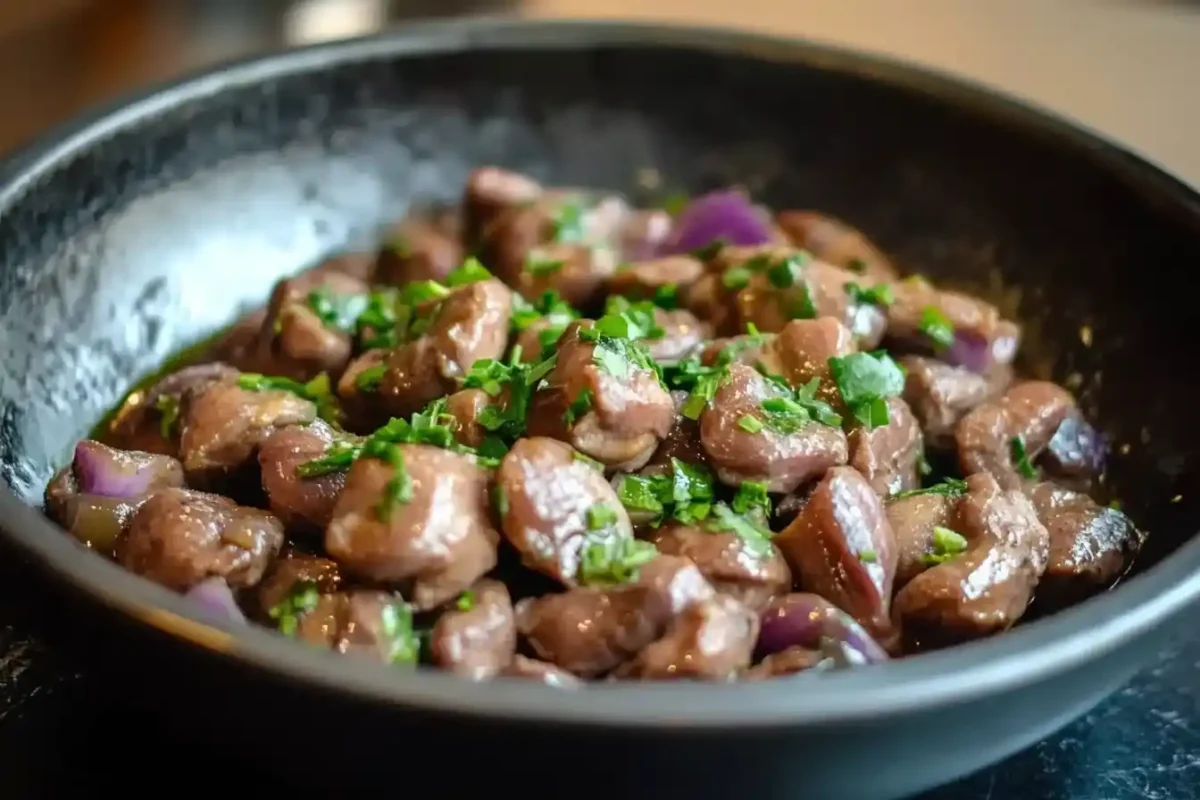Explore chicken hearts nutrition, flavor, cooking tips, and global recipes to create delicious, healthy meals at home.
Introduction
Organ meats have gained popularity in recent years, albeit once overlooked. These stand out as a nutrient-rich and flavorful choice. Accordingly, many American home cooks have begun exploring this affordable delicacy.
Because chicken hearts are often considered offal, some people hesitate to try them. Nevertheless, they offer complex flavors and a unique texture that is comparatively tender. Moving to the next part, you will learn more about what chicken hearts are, their culinary significance, and why many chefs, both home and professional, celebrate them. For a detailed comparison of nutritional benefits, you can explore Chicken Liver vs Beef Liver: Which Is Better?.
In the upcoming section, we will delve deeper into the nature of chicken hearts, unraveling misconceptions and explaining their rich culinary history. Eventually, you will understand why they hold an esteemed place in various cuisines, extending far beyond their traditional roots.
Understanding Chicken Hearts
dense muscle organs found inside the poultry cavity. Basically, each heart is about the size of a large grape. Although tiny, their flavor is intense and richer than standard muscle meat. Moreover, they often come packaged with gizzards and livers, collectively known as giblets.
Contrarily to popular belief, chicken hearts are not the same as gizzards. The gizzard is a tough, muscular organ, whereas the heart is leaner and somewhat more tender. Correspondingly, the heart boasts a more pronounced, umami flavor. Another notable aspect is that chicken hearts have long been part of global culinary traditions. Brazilians, for example, grill them over open flames on skewers. In many Asian cuisines, they show up in stir-fries, soups, and skewered appetizers (yakitori).
Historically, offal, including chicken hearts, played a key role in nose-to-tail eating. Basically, this practice uses every part of the animal. Formerly, it was a necessity driven by scarcity, but now many modern chefs appreciate offal’s complex flavors. In the succeeding section, we will examine their nutritional profile, showing exactly why these small morsels pack a healthy punch.
Nutritional Benefits of Chicken Hearts
They contribute greatly to a balanced diet, supplying high-quality protein essential for muscle repair and growth. Comparatively, they deliver protein levels similar to lean poultry cuts but in a smaller package. Equally important, their impressive micronutrient profile appeals to nutrition experts and health-conscious eaters.
Certainly, they contain iron, vital for oxygen transport in the body. They also provide vitamin B12, supporting nervous system function and energy production. Additionally, they offer significant amounts of zinc, phosphorus, and selenium. Another advantage is their low calorie count paired with high nutrient density, making them ideal for those seeking nutrient-rich, lower-calorie foods.
Although they do contain cholesterol and some saturated fat, moderate consumption can fit into a balanced diet. Accordingly, portion control ensures benefits outweigh potential drawbacks. Many diets, i.e., paleo, keto, and Whole30, incorporate offal to enhance nutritional variety. Identically, some athletes appreciate the rich iron and protein content.
Hitherto, we have established that they are nutrient-dense, but you must select, prepare, and cook them correctly to reap these benefits. In the ensuing segment, we detail how to pick the freshest, prepare them properly, and store them for maximum flavor and safety.
Selecting and Preparing Chicken Hearts
In the next chapter, choosing quality chicken hearts is crucial. Firstly, look for a deep red color and firm texture. Fresh hearts should smell clean, not sour or musty. Ideally, purchase from reputable butchers, local farmers, or well-regarded grocery stores. Secondly, consider organic, pasture-raised birds for a cleaner flavor and more ethical sourcing.
Before cooking, rinse hearts under cold water and trim excess connective tissue or fatty deposits. Afterwards, you can marinate them in an acidic mixture, such as vinegar or citrus juice, combined with herbs and spices. This approach tenderizes the meat. Practically, this step ensures that even a novice cook can achieve a tender, well-seasoned result.
Storing chicken hearts demands care. Keep them in the refrigerator if you plan to cook them within a day or two. Otherwise, freeze for up to three months. Make sure they are sealed airtight. Undoubtedly, proper storage preserves flavor and quality. Transitioning to the next portion, we focus on cooking methods and techniques, helping you transform raw hearts into succulent dishes.

Raw chicken hearts garnished with parsley, ready for cooking.
Cooking Methods and Techniques
Advancing to the next topic, let’s explore different cooking methods for chicken hearts. Sautéing them in a hot pan with butter, garlic, and herbs is a quick method. Just cook over medium-high heat until they reach a safe internal temperature. Another technique involves grilling them on skewers. Brazilian churrasco often features seasoned chicken hearts grilled over charcoal until they develop a smoky, charred flavor.
Comparatively, slow cooking or stewing yields tender, melt-in-your-mouth textures. Add aromatics, broth, and vegetables. Let everything simmer gently until the hearts absorb the flavors. Alternatively, frying them in a well-seasoned batter gives a crispy exterior. But be mindful of oil temperature to prevent greasiness.
For culinary enthusiasts, sous vide cooking offers precise temperature control. Cook the hearts in a sealed bag in a water bath, then sear quickly. If your hearts come out tough, consider marinating longer or adjusting the cooking time. Lest you end up with rubbery results, remember that shorter cooking times over high heat usually keep them tender.
Proceeding to the next chapter, we delve into the world of flavor enhancements and seasonings. Proper seasoning transforms chicken hearts from simple organ meat into a gourmet delight.
Flavor Profiles and Seasonings
Here’s a simplified version of your text, replacing complex words with easier alternatives:
In the next section, think about the flavors that go well with chicken hearts. Garlic, onion, thyme, and rosemary make a tasty base. Similarly, smoked paprika, cumin, and coriander seeds add a deep, earthy taste. A bit of chili flakes or hot sauce can also bring some heat.
You can also try seasoning blends from around the world for more variety. For example, a Latin American marinade might use lime juice, oregano, and cilantro. On the other hand, an Asian-inspired mix could include soy sauce, ginger, and sesame oil. By using spices wisely, you can bring out the rich.
Sauces and dips make the dish even better. For instance, chimichurri goes well with grilled chicken hearts because of its fresh herbs and tangy flavor. Another option is peanut sauce for a creamy richness, or spicy aioli for a mix of heat and creaminess. In the next part, we’ll explore recipes from around the world that use these flavors and methods, helping you try new dishes.
Cultural and Global Recipes
Heading into the subsequent area, let’s explore how cultures worldwide celebrate chicken hearts. In Brazil, chicken hearts are a beloved street food. They grill them on skewers and serve as a flavorful snack. Also, in certain Asian countries, skewered hearts, known as yakitori, are a popular bar food. They are seasoned with soy sauce, mirin, and sugar, offering a savory-sweet glaze.
Throughout Europe, chefs sauté chicken hearts in butter, white wine, and garlic. This creates a silky sauce and a simple yet elegant dish. Meanwhile, Mediterranean cuisines might add olives, tomatoes, and herbs. Similarly, blending global influences, you can stuff tortillas with marinated, grilled hearts, top them with fresh salsa, and serve as tacos.
Evidently, chicken hearts integrate well into rice bowls, salads, and soups. They are also a great protein addition to pasta dishes. Doubtedly, global inspiration ensures no shortage of creative recipes. In the next subsection, we discuss how to serve these dishes attractively and pair them with sides that complement their distinct flavor.
Serving Suggestions and Accompaniments
Moving on to the next topic, think about the sides that go best with chicken hearts. Since they are rich and flavorful, pair them with mild, starchy sides. Rice, potatoes, or quinoa make a simple base. Also, roasted vegetables like carrots, parsnips, and beets add a touch of sweetness. Another idea is to serve them with a fresh salad or tangy coleslaw, creating a mix of textures and flavors.
Additionally, serving chicken hearts as a starter lets guests try something new without committing to a full meal. Skewered hearts with grilled peppers and onions make a colorful plate. Add fresh herbs or a little citrus zest for extra brightness.
Finally, how you serve the dish makes a big difference. A bright garnish, a drizzle of sauce, and a neat plate setup can make chicken hearts more appealing. Next, we’ll talk about dietary needs and health tips to ensure safe and healthy eating.

Tender chicken hearts stewed and garnished with parsley.
Dietary and Health Considerations
Continuing in the next section, it’s important to talk about health factors when eating chicken hearts. While they are packed with nutrients, they do contain cholesterol, which some people monitor closely. Eating them in moderation is key. Small amounts enjoyed occasionally can fit into most balanced diets. However, people with certain health conditions should talk to a doctor for advice.
Making sure food is safe is crucial. Always cook chicken hearts to the right internal temperature (at least 165°F) to kill harmful bacteria. Wash your hands, utensils, and cutting boards well before eating or preparing them. Also, buy from trusted suppliers who follow safe and ethical farming practices.
If you follow special diets like paleo, keto, or gluten-free, chicken hearts are easy to include because of their simple makeup. They offer key nutrients without added ingredients. In the next part, we will answer common questions to clear up doubts about chicken hearts.
Frequently Asked Questions (FAQs)
1. Are chicken hearts good for you?
Yes. Chicken hearts provide good-quality protein, iron, vitamin B12, and other nutrients. Also, they help with energy, blood health, and keeping your body working well. While they have cholesterol, eating them in small amounts as part of a balanced diet can be good for you.
2. What is chicken heart made of?
A chicken heart is a small, muscular organ responsible for pumping blood throughout the bird’s body. Composed chiefly of lean muscle tissue, it is dense in nutrients and flavorful compounds. Basically, it’s a rich source of protein and essential micronutrients.
3. Are chicken hearts gizzards?
No. Chicken hearts differ from gizzards. Gizzards are muscular organs that grind food for digestion, resulting in a chewier texture. The hearts of chickens are softer and have a distinctive taste profile. Contrarily, gizzards often require longer cooking times, while hearts are tender and simpler to prepare.
4. What do fried chicken hearts taste like?
Fried chicken hearts have a crispy exterior and a tender interior. They taste savory and slightly mineral-rich, similar to dark poultry meat with a more intense flavor. Adding seasonings or sauces can complement their unique taste.
Conclusion
In the next section, we review what we’ve learned: chicken hearts are tasty, healthy, and enjoyed in many cultures. They are rich in protein, vitamins, and minerals. Cooking them can be simple. By choosing, cleaning, and marinating them well, you can create soft and flavorful dishes.
Trying out different spices, cooking styles, and recipes from around the world can make your cooking more exciting. While some may hesitate to try offal, chicken hearts offer unique and delicious flavors. Adding them to your meals can make your diet both healthy and enjoyable.
In the following part, we’ll share tips on using metadata for images, helping you create appealing and effective visuals.

